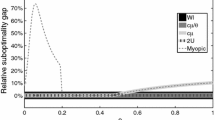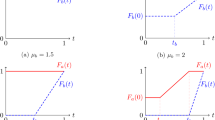Abstract
We study a multi-class queue with a “learning” server who becomes stochastically faster with each subsequent customer served of the same type in a row, and returns to some baseline speed each time he switches to a different type of customer. We show under some conditions that customer waiting time is larger (in the increasing convex ordering sense) with server learning than in a queue with iid service times having the same marginal service distribution as the learning server. An easy to evaluate inequality for the mean stationary waiting time is derived from this in the case of Poisson arrivals, and results in more general settings are given. The primary tool used in the proofs is the supermodularity of the delay in queue as a function of previous service times.
Similar content being viewed by others
References
[1]N. Bäuerle, Monitonicity results for MR/GI/1 queues, J. Appl. Probab. 34 (1997) 514-524.
[2]N. Bäuerle and T. Rolski, A monotonicity result for the workload in Markov-modulated queues, J. Appl. Probab. 35 (1998) 741-747.
[3]J.H. Dshalalow and L. Tadj, A queueing system with random server capacity and multiple control, Queueing Systems 14(3/4) (1993) 369-384.
[4]S. Gilbert and Z.K. Weng, Incentive effects favor non-consolidating queues in a service system: The principal-agent perspective, Part 1 of 2, Manag. Sci. 44(12) (1998) 1662-1670.
[5]H. Li, Y. Zhu, P. Yang and S. Madhavapeddy, On M/M/1 queues with a smart machine, Queueing Systems 24(1/4) (1996) 23-36.
[6]A. Mandelbaum and M. Reiman, On pooling in queuing networks, Manag. Sci. 44(7) (1998).
[7]L. Meester and G. Shanthikumar, Regularity of stochastic processes: A theory based on directional convexity, Probab. Engrg. Inform. Sci. 7 (1993) 343-360.
[8]G. Pestalozzi, A queue with Markov-dependent service times, J. Appl. Probab. 5 (1968) 461-466.
[9]S.M. Ross, Introduction to Probability Models, 5th ed. (Academic Press, San Diego, CA, 1993).
[10]S.M. Ross, Stochastic Processes (Wiley, New York, 1996).
[11]S.M. Ross, J.G. Shanthikumar and X. Zhang, Some pitfalls of black box queue inference: The case of state-dependent server queues, Probab. Engrg. Inform. Sci. 7 (1993) 149-157.
[12]J.G. Shanthikumar, On a single-server queue with state-dependent service, Naval Res. Logist. Quart. 26(2) (1979) 305-309.
[13]T. Takine and T. H asegawa, The workload in the MAP/G/1 queue with state-dependent services: Its application to a queue with preemptive resume priority, Comm. Statist. Stochastic Models 10(1) (1994) 183-204.
[14]D. Topkis, Supermodularity and Complementarity (Princeton Univ. Press, New York, 1998).
Author information
Authors and Affiliations
Rights and permissions
About this article
Cite this article
Peköz, E.A., Lapré, M. Inequalities for Queues with a Learning Server. Queueing Systems 37, 337–347 (2001). https://doi.org/10.1023/A:1010806832532
Issue Date:
DOI: https://doi.org/10.1023/A:1010806832532




